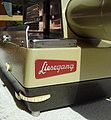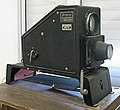Liesegang (company)
Liesegang was a company specializing in daylight projectors and multimedia projectors with its headquarters in Essen and is now a brand and department of TAS-media.com GmbH in Bochum. The Liesegang company was founded in 1854 and was named Ed. Liesegang oHG in Düsseldorf , a traditional German manufacturer of projection technology .
history

Friedrich Wilhelm (FW) Eduard Liesegang (1803–1871) was the founder of the Ed. Liesegang oHG , which became known for its projectors .
In 1854 Eduard Liesegang took over a photo business and founded the company. His son Paul Liesegang (1838–1896) published a standard work on photography in 1856 , founded the magazine Das Fotografische Archiv in 1860, and in 1877 submitted the first Liesegang patent . At the end of the 19th century, a grandson of the founder and later co-owner of the company, the chemist Raphael Liesegang , developed ideas for "electrical television " and the forerunners of the videophone . At that time the company owned a photographic factory in Elberfeld . In 1873 the company moved to Düsseldorf , where it settled on Kavalleriestraße.
When Paul Liesegang died in 1896, his son Raphael Liesegang and two of his brothers took over the factory, which they modernized. The photo paper and developer department was sold to the Friedrich Bayer & Co. paint factory in Leverkusen in 1907 . This would later become the nucleus of the Agfa works. When Raphael Liesegang left the company, the optical department was continued by his brothers in Düsseldorf. Shortly after the turn of the century, optics and projection technology had established themselves as the company's focus. In 1926 the company moved to an area in Düsseldorf-Unterbilk . The site of the Alte Liesegang factory , Volmerswerther Straße 21, where slide projectors were previously produced, has now become a center for artists and designers.
After the insolvency of the former family-owned Liesegang oHG in 2004, the company was re-established in 2006 as Liesegang Technology Vertriebsgesellschaft mbH , based in Essen. Around 50 employees achieve an annual turnover of around 30 million euros. Today the company is a department of TAS-media.com GmbH in Bochum.
developments
Raphael Liesegang developed the first matt celloidin paper and the hydroquinone developer Aristogen in 1892 .
Important developments were in 1913, the first projector with Metallfaden- bulb or 1931 mm film projector and an enlarger for the popular expectant mm photography. The first spill-proof slide magazines were developed and produced in 1954. In 2001 the brightest ultraportable data video projector in its class was introduced ( Liesegang ddv 1111 ultra with 1,700 lumens and a weight of 2.9 kg).
Products
Cameras
After it was founded in 1854, the focus was primarily on the manufacture of "photographic articles" for personal use and they were then successfully offered for sale. After just three years, the first cameras were manufactured in an art carpentry shop.
Slide projectors
Typical Ed. Liesegang oHG were film projectors ( Diafilmax ) and slide projectors of the series
- Diafant and Neo-Diafant ( ca.1940s )
- Fantax (c. 1950s to 1970s)
- Fanti Automat and Fantimat (approx. 1970s to 1980s)
- Junior and the 3000 series (e.g. Liesegang 3600 AF selectiv) (since around the 1980s)
The Liesegang Avanti was a projector for large format slides (13 cm × 13 cm). The projectors were often equipped with projection lenses specially manufactured for Liesegang ( Omar , Sigmat , Patrinast , Sankar ).
Movie projectors
Episcopes, epidiascopes, antiscopes
“Globoskop” episcope , approx. 1913, with four 55-volt light bulbs
Epidiascope Janus , ca.1910, episcopic projection deflected from above via a mirror
Liesegang E6, template size DIN A4 portrait and landscape, two 1000 watt halogen floodlights
Also Antiskope , periscopes and Epidiaskope were made - for example the "Megadiaskop" Janus , the periscope and slide projector in one. The projection lenses were called Janar . Newer types have been equipped with objectives such as the Novotrinast anastigmat (1: 3.6 / 330 mm) or the very large Meganast anastigmat (1: 5.5 / 1000 mm).
Enlargers
Overhead projectors
Video projectors
Other products were microfilm readers .
Today's product range is dominated by daylight projectors and video projectors . While the production and sales of slide projectors have been discontinued, an episcope is still on offer.
literature
- Claus Priesner: Liesegang, Eduard. In: New German Biography (NDB). Volume 14, Duncker & Humblot, Berlin 1985, ISBN 3-428-00195-8 , p. 537 ( digitized version ).
Web links
- Company homepage
- Handbook of practical cinematography by Franz Paul Liesegang on Gutenberg.org
- Images from different projectors in fr.wikibooks
- Sally Schöne, Matthias Knop: Düsseldorf stories in the exhibition "Magic of Light and Shadow" . In: Jan Wellem . 87th year, issue 3, 2012 (PDF in the portal aldeduesseldorfer.de )




















































